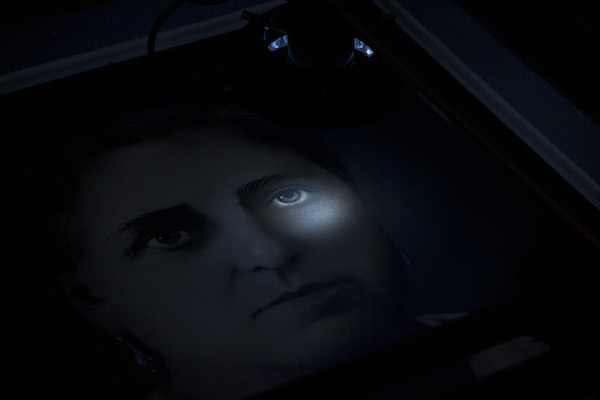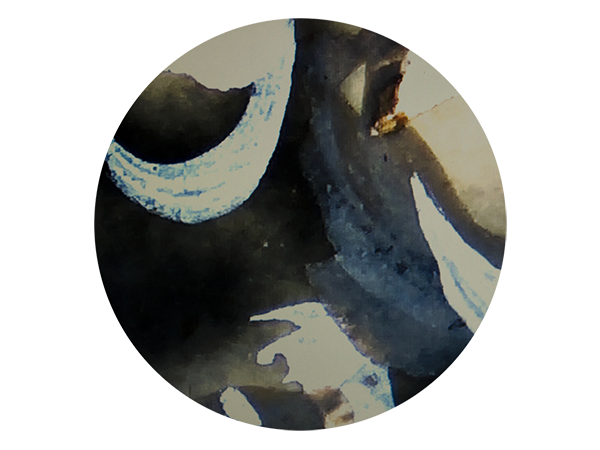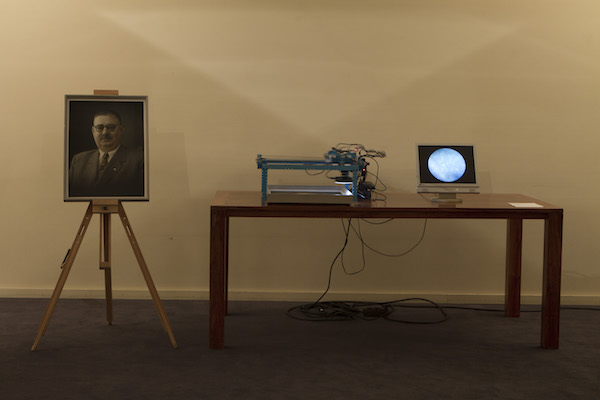Pair of found photographic portraits, signed by ‘Fotografia Beleza’, Porto (Portugal). Date unknown.
www.familyfilmproject.com/en/editions/program/x-y-installation/”

(…) “There is nothing in the world less ‘natural’ than an image… with the possible exception of silence: Both are supreme artifices.” (…)[1]
Hollis Frampton[2]
This work involves two twin-framed portraits (50×60 cm), of a man and a woman. Found (and bought) together on a charity shop in the city of Porto (Portugal), both have the signature of ‘Fotografia Beleza'[3], a photographic studio well known and very active in the first half of the twentieth century. The portraits show no identification of subjects or dates, they represent unknown people to this day. I am calling them Mrs X and Mr Y.
The fact that these portraits were found together suggests they were a couple, but this affiliation is not verified. This artistic simulacrum is more concerned with building a universe of possibilities from the finding of two portraits depicting a man and a woman, than to reconnect the photographs with the reality behind them.
It must be said that the use of light and composition is good, as much as would be expected from a notorious commercial studio. Soft light, precise focus, careful arrangement of clothes and accessories, frontal gaze towards the camera despite a slightly oblique positioning of the body. Light in the faces comes from above on the left side, it is diffused and seems the kind of natural light that enters a glass roof, reflected by the northern sky.[4]
Formally these are the kind of portraits, which could be miniaturized for identification documents or enlarged and put behind frames for the wall, as is the case.
To identify the people in these portraits should not be too difficult, since most of the assets of this studio were bought by a private collector and subject of an inventory around 2007. According to the report published on the website created to advertise the project[5], the studio kept very accurate and organized records of their work, which made the job of classifying much easier. Therefore it is likely that the negatives and a record of a commercial transaction still exist which, could help recover a possible identity and a date. Despite all that, I do not intend to clearly identify these portraits, I do not claim property of them and I do not refuse the possibility of giving them away to anyone who can prove to have a relationship with these people.

On a close inspection the portraits reveal layers of paint over the photographic tones and grain, more visible and notorious on the woman’s portrait. The paint is most evident in the eyes where the photographic detail is completely hidden, but was also applied freely in the earrings, which seem to have been created solely from brush strokes. Being a woman seems to demand more attention and greater pictorial effects (make up).
The signature ‘Fotografia Beleza, Porto’ is also painted and seems to point out that what we are looking at is an ‘authored’ work, making more obvious the hybrid nature of these portraits. Nonetheless its authorial identity is not of a single person but a commercial brand instead, denoting very likely a collective work.
The fact that the portrait of the woman has much more paint over certain areas than the portrait of the man, could have another explanation though. The photograph seems to have less definition and detail itself when compared to the other, this could mean this is not a print from a first generation negative, and if that’s the case the paint could have been intentionally applied to help sharpen certain areas blurred by the reproduction of a photographic print (probably a small one) on a new negative, and consequently a new print.
A photographer (or an employee of a photographic studio) would only recur to the reproduction of a printed portrait on the event of the disappearance of the person and therefore the impossibility of making an updated one. It could be then, that a widowed Mr Y wanted to hang the picture of the late wife next to his in the wall of the living room, went to ‘Fotografia Beleza’ with just a small print and asked what could be done of it. Not an uncommon request then and now, just different means to achieve the same porpose.
On a photographic studio of the fist half of the twentieth century, the manual retouch of negatives and prints was a very serious matter. Graphite pencils with several levels of hardness would be used in large negatives or printed positives on mate papers, to subtract or add wrinkles and other beauty marks. A red translucent paint would be applied to certain faces on negatives, to avoid reproducing them too dark, due to the lack of sensitivity of some photographic materials on near red and green wavelengths of the spectrum. The final retouch on the print would be applied by the most skilled on the painterly arts. Special watercolour would be used to add subtle colour tones without covering photographic detail in some cases. On others, the photograph merely became the matrix for a complete new painted interpretation.
All of these pictorial modes of intervention on a photograph seem present on Mrs X portrait, making it a perfect hybrid and a good object of study.
.jpg)
Many of the first photographers began their artistic practice as painters and although the medium was predominantly monochromatic in the first one hundred years of its history, colour was desired, researched and apllied pictorially, since the birth of the early photographic methods. With or without colour, the fate of photography as an image making process was to learn from the centuries long pictorial history, in what concerns the representation of light, composition and even the themes explored.
The pictorial layers over Mrs X portrait not only deny time but they transform it into a sort of palimpsest[6], an accumulation of gestures imprinted on a face.

Printed photographs like the portraits of Mrs X and Mr Y are unique because in practice it is impossible to reproduce exactly the same conditions in which the photographs were created, before and after the uncertainty of the hand manipulating pictorial matter concluded their final appearance. In this case, the original negatives were just the beginning of a complex process of image making, if compared to the finished product they would reveal nothing but an impression, a footprint. Ultimately it is the layers of painting that strengthen the uniqueness of the photographs and render them irreproducible.
I am surprised and delighted that the portraits survived decades, keeping a relatively healthy appearance, not showing strong signs of fading or chemical deterioration, revealing that possibly they have spent most of their existence in subdued light.
The physical and chemical processes from which photography depends are unstable, no matter how perfected they are, therefore the permanence of photographs is impossible to ensure, we can only delay their process of decay. The variables behind this process of mutation are identified: light, temperature and humidity. Museums and institutional archives carefully monitor and control these variables to extend the life of objects, slowing down as much as possible the process of change[7].
One of the most important rules of preservation of works of art and specially photographs, is to keep them away from any direct light. Light changes matter, modifies our skin, fades colours of clothes and billboards. The raw material of all photographs and the spirit behind all works of art is both an agent of creation and of destruction.
The ageing process imposed by light in photographs, varies with the intensity and quality of such light, the nature of the materials exposed and interaction with the other variables. Under normal circumstances, in a framed portrait hung on a living room away from direct sunlight, the process of change can be very slow and only noticeable over long periods of time. Therefore, as our experience has been proving, it is very likely that photographs outlive the people who made them or the ones they refer to, and so the portraits I am submitting to this experiment should outlive me, despite the exposure I intend to give them.

The paint over Mrs X’s eyes, hide its imperfections underneath. It is the superimposition of these layers that make it interesting and erotic, the artifice enveloping the image.

In this work I wanted to conciliate the moving image over the portrait of Mrs X with the staging of the technical process of the research in an installation, somehow suggesting the aesthetics of the conservation lab, while submitting the photographs to a detailed and continuous exploratory observation. Such staging of a process required not only a sophisticated device for the capture and projection of a video feed, but also a permanent exposure of the images to intense light.
Light will reveal but also impose a slow destruction of the image, therefore the work manifests itself as anti-conservationist.
The device, applied to the portrait of Mrs X is a robot capable of scanning the image on a perpendicular plane on an X and Y axis. It can be programed to move the video camera attached to it very slowly across assigned coordinates, delivering a continuous traveling over the portrait, fed to a monitor in real time.
There is no recording involved, the camera moves on a programmed itinerary as a loop, meaning it will go back to the same place where it began and repeat the same movements and pauses, indefinitely, this functions as a kind of visual editing. The variables that can be edited in the code are limited to speed of movement of the head (camera), location and duration of pauses. The itinerary was carefully delineated to pause in some key places of the face of the woman, for periods that range from 5 to 30 seconds. The loop takes about 9 minutes to restart.
The moving image is presented on a video monitor masked as a circle, as if we were observing the projection of light through a lens in the camera obscura. We are in fact merely witnessing the projection of an image not recording it, therefore it does not intend to be a movie. It is a surveillance and projection event, not the recording in a still or moving image that one could replay over and over.
By choosing Mrs X as the centre of the attention in the installation, the man Mr Y, is left standing in the shadow, as if waiting in line, but never out of sight. He waits and suggests the work could evolve and become more complex (he may also be submitted to some kind of accelerated mutation on a next level of development).
Ultimately, this work brings robotics and video as mediators/modifiers of photographic images, a reflection of present times and an important factor of experimentation in my practice. This connects also with my previous exploration of movement over still photographs (Short Narratives). On another level it brings the family as an underlying theme in my research. The scan over the portrait of the woman is a conscious meditation and a comment (at least in my vision of things) on the gaze of genre (male-female or vice-versa) and of surveillance and its political implications in our privacy and freedom.
As fotografias originais que são o objeto deste trabalho foram adquiridas sem qualquer informação associada sobre a sua origem, autoria ou identificação das pessoas representadas. Supomos que essas pessoas já desapareceram, mas se não for esse o caso e alguém conseguir identificar ou provar uma relação com elas, fazemos questão de as identificar, respeitando a autoria ou lhes devolver os originais.
The original photographs included in this work were acquired with no information at all on their origin, authorship or identity of the people depicted in them. We assume these images were lost because whoever they belonged to disappeared. If that is not the case, and this work is seen by someone who can identify and prove a relationship to the people in the pictures, or the one who made them, we will gladly identify them, respecting their authorship or return the originals.